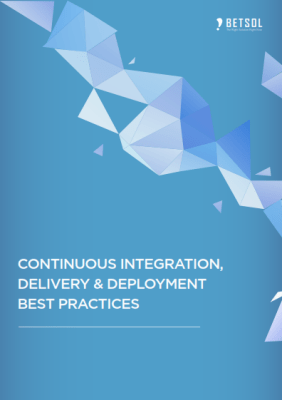In this article, you’ll find details and research on an advanced software engineering model that brings fast time-to-market, high-quality deliverables, and more time spent on innovation. At the end of the article, you can also download our full “Continuous Integration Best Practices for Software Engineering” white paper PDF.
Drastically Change Software Time-to-Market
As innovation excels, moving features to market quickly has become an incredible differentiator. Releases comprised of multiple features have long development life-cycles. This means great ideas can take many months to years to be released. What can happen during this time?
- Competitive advantages through innovation are lost
- Feature sets can become obsolete
- Security vulnerabilities can be present
The continuous development (integration, delivery, and deployment) methodology allows developers to integrate software code multiple times per day into production. This enables you to:
- Keep ahead of the competition
- Resolve quality issues more simply
- Respond to security concerns quickly
Continuous integration, delivery, and deployment reduce the barriers between your ideas and your customers. Read more to learn why companies such as Amazon, LinkedIn, Microsoft, Etsy, Netflix, and many others rely on continuous development practices.
What are Continuous Integration, Delivery, and Deployment?
In order to have a successful end-to-end system for continuous development, three areas are considered: integration, delivery, and deployment.
How does Continuous Delivery Perform in Real Life?
In a 2014 study of high-performing organizations utilizing these development methodologies, the following conclusions were observed (ThoughtWorks & Puppet Labs, 2014) as compared to industry peers using traditional methods:
An internal study at Hewlett Packard (A Practical Approach to Large-Scale Agile Development) provided similarly outstanding results:
- 40% reduction in development costs
- 140% increase in programs under development
- 78% reduction in development cost per program
- 5x increase on time spent on innovation
“We know our quality within 24 hours of any fix going into the system… and we can test broadly even for small last-minute fixes to ensure a bug fix doesn’t cause unexpected failures. Or we can afford to bring in new features well after we declare ‘functionality complete’ – or in extreme cases, even after we declare a release candidate.” – A Practical Approach to Large-Scale Agile Development
How are Stakeholders Impacted by Continuous Development?
Different audiences are impacted differently by this continuous integration, delivery, and deployment. Overall, by developing a standardized process, everyone wins by smoother operations, better quality, and faster-to-market features.
| Customers | As the most important audience of your software engineering, customers are also at the center of continuous development. Customers receive smaller updates on a more regular basis. This allows for a natural evolution of feature sets with minimal impact to their experience with the software. Additionally, security updates and patches will be pushed faster, minimizing exposure. |
| Business Managers | Business managers are now more in control of the production environment. Features are queued up and ready for deployment at their discretion and “push of a button.” Since managers no longer need to wait for multiple features compiled into a single build, they will also see results and features faster. |
| Developers | The entire development process becomes much more stable and predictable. Developers will not operate in a “mad rush” prior to release windows. Less is at risk with each deployment, and pinpointing the cause of any problem is more automated and requires less investigation. Developers, therefore, are able to focus on using their talents to push the software forward. |
| System Administrators | Similar to developers, the function of a System Admin becomes much more predictable and stable. The work is now about continuous, discrete changes that are easier to deploy, measure, troubleshoot, and resolve. |
Keeping Ahead of the Competition and Security Vulnerabilities
Continuous development practices allow companies to rapidly deploy features to production, but also give companies the ability to re-prioritize and deliver without waiting on broader build readiness. This ability to quickly shift and deliver is a competitive advantage.
Staying Ahead of the Competition with Continous Integration
With traditional development practices, the timeline from “unique business idea” to “realization by customer” can take months or years. Minor updates and features are packaged with larger ones to create a release, further pushing back delivery times. With the current speed of business, that can be unacceptable in many cases.
In fact, a study showed the majority of business decision-makers want their software ideas to hit the market in under 6 months, yet in reality, it takes between 6-12 months to deliver these features on average (Forrester Consulting on behalf of Thoughtworks).
Continuous development methodologies alleviate this pain point and bring innovation to the market faster. Further, given the stability of the developer’s role, internal innovation is better allowed to flourish.
Security Vulnerabilities and Continuous Integration
Software security is a growing concern for consumers and businesses. Exploits occur quickly and must be dealt with immediately. Continuous development methodologies afford you the ability to reprioritize, quickly deploy, test, and go to production, giving your business and its customers peace-of-mind. Since vulnerabilities often lie in the framework of software, quick and automated integration testing makes it simple to trial framework releases and patches.
How is Continuous Development Achieved
If continuous development practices may benefit your organization, it is time to consider contacting a vendor that specializes in continuous integration, delivery, and deployment or building out your own systems, including:
- Continuous integration servers
- Automated test solutions
- Supporting processes and procedures
BETSOL is a leader providing leading-edge development practices and standards. BETSOL’s expertise can provide you consulting or a complete hosted and staffed solution, delivering class-leading results for your development organization. Further, BETSOL utilizes a proprietary market-driven software development methodology that can magnify the results organizations see when leveraging continuous integration.
Next steps
- Download the Continuous Integration White Paper PDF.
- Learn about BETSOL’s Software Engineering offers.
- Let one of our experts discuss these best practices and whether or not they can assist your organization. Contact us.






